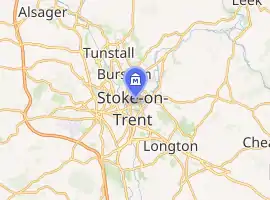Potteries Museum & Art Gallery
The Potteries Museum & Art Gallery is in Bethesda Street, Hanley, one of the six towns of Stoke-on-Trent in Staffordshire. Admission is free.
 Museum entrance | |

| |
| Location | Hanley, Stoke-on-Trent, United Kingdom |
|---|---|
| Coordinates | 53.0229°N 2.1781°W |
| Type | Art museum & local museum |
| Visitors | over 100k per annum |
| Director | Keith Bloor |
| Curator | Curators for Arts, Ceramics, Natural Science and Local History |
| Website | www |
One of the four local authority museums in the City, the other three being Gladstone Pottery Museum, Ford Green Hall and Etruria Industrial Museum, The Potteries Museum & Art Gallery houses collections that bring together the identities that went into forming the area known as the Potteries. The museum holds a collection of Staffordshire ceramics.
All the collections at this museum are categorized as Designated Collections. Galleries display fine and decorative arts, costume, local history, archaeology and natural science collections. There is a second world war aircraft on permanent display, a Supermarine Spitfire whose earlier Marks were designed by R. J. Mitchell who came from nearby Butt Lane.
History
The museum opened on its current site in 1956 as the Stoke-on-Trent City Museum & Art Gallery.[1][2] The building was designed by the city architect; J. R. Piggott.[1]
Over the winter of 1985/6 the spitfire was moved from its previous home in a glasshouse outside the museum to a specially constructed gallery within the museum.[3]
Since February 2010, The Potteries Museum & Art Gallery has been the home of a number of artefacts from the Staffordshire Hoard. 52,500 visitors viewed 118 items at the Potteries Museum during a 23-day exhibition in February 2010.[4] Since Birmingham Museum and Art Gallery and Stoke-on-Trent Museums have purchased the Hoard, items have been on permanent display at both venues. Over 80 pieces can be seen in The Potteries Museum & Art Gallery's archaeology gallery. Redevelopment of the Saxon part to this gallery in the latter half of 2010 has set the Hoard within a more tangible context, using existing pieces from the museum's collection of Staffordshire archaeology.

In 2012 the museum ran an exhibition on the subject of connections between Stoke-on-Trent and the Titanic.[5] It included information on people from the area who died in the sinking and archive footage of Captain Edward Smith who was born in Hanley.[5]
On 28 February 2017, the Leekfrith torcs, believed to be the oldest Iron Age gold jewellery found in Britain, were unveiled to the public for the first time, at the museum.[6] From the following day, they were placed on public display.[6]
In June 2017 a bronze statue of Arnold Bennett was located on the pavement just next to the front entrance to the museum.
References
- Jenkins, J.G, ed. (1963). A History of the County of Stafford: Volume 8. London: Victoria County History. pp. 259–271.
- "About Us". Stoke-on-Trent museums. Stoke-on-Trent City Council. Retrieved 23 August 2020.
- Warbrook, Colette (17 January 2018). "The day the Spitfire arrived at the Potteries Museum and Art Gallery, in Hanley, in 1985". The sentinel. Retrieved 31 August 2020.
- http://www.esci.keele.ac.uk/nsgga/bulletin/bulletin093.pdf
- "Film of Titanic captain Edward Smith at Potteries Museum". BBC News. 11 February 2012. Retrieved 11 February 2012.
- "'Oldest' Iron Age gold work in Britain found in Staffordshire". BBC Online. 28 February 2017. Retrieved 28 February 2017.